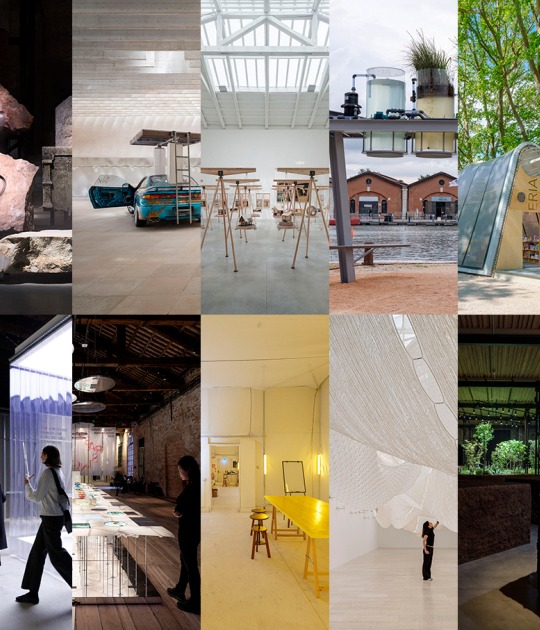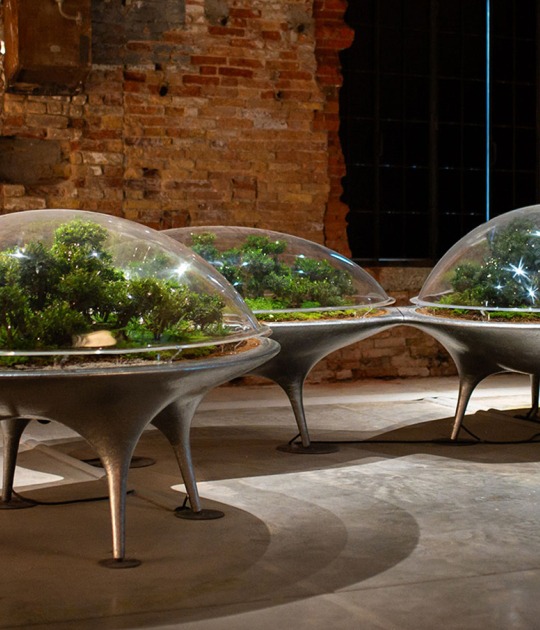Description of project by MAGICARCH
Portable architectures performing common ecologies
With this project, I am interested in finding the Common Ecologies from my current position in Architecture. In a planetary look that is already evolving towards a post-Anthropocene, we can accuse the urgency of rereading the past Ecologies that have interfered in negotiations and architectural creations. Looking at how energy is distributed or how resources arrive, establishing readings about the interspecies, the ethical normalization of Dolly the sheep, or how programmed obsolescence begins to be a matter of political design, reading this past ecology we can articulate new interests from common ecologies.
The Portable Architectures that are presented in this project relate an eco-reflection from the construction of 12 devices, devices that are transportable and wearable, and that stage the common ecologies of 12 buildings in the History of Architecture. Through her performance, new readings emerge of Lina Bo Bardi's MASP that reconstructs its anti-colonial cultural landscape, Giacomo Matte Trucco's Fiat de Lingotto Factory that shows the thicknesses of the Anthropocene, Magicarch's Breathing Domes project that articulates contradictions of biodesign or the Aguahoja by Neri Oxman that tells of new connectors of interspecies architecture. In short, the twelve cultural icons on which this work focuses have a universal and pedagogical interest, which is staged in a sequence of audiovisuals of complementary anthropized landscapes. The portability and performativity of Portable Architectures allow us to continue learning about the cultural value of each of these works of Architecture.
The pandemic and its virtual synonyms have further exacerbated the deficiencies produced by the absence of these common ecologies. Thus, each device is re-enacted in the body that stages them, telling new versions that reveal questions of political ecology, becoming a new material interface of cultural transfer, a physical device, a pedagogical sculpture, a tangible sculpture that you can wear. , show off and touch. In the history of architecture, several ‘Manifestos’ appear that redraw icons of Architecture from new scales of approach, Madelon Viesendrop and Rem Koolhaas humanize them in bed in intimate scenographies, while Piranesi de-anthropizes them with his engravings, returning them to Nature.
About some Common Ecologies that I build from each ‘Portable Architecture’
1 Korean Hanok Portable Architecture 57 BC
Adaptive Ecologies
Hanok is one of the most adaptive architectures that remains immovably in our anthropized history. This pre-Darwinian adaptability emerges in Korea even before the nation itself existed as such, in 57 BC. The concept of Hanok is a precursor to many pre-Darwinian theories and even a precursor to the understanding of cosmopolitics. Hanok is articulated as a way of life close to the earth, a land heated by the 'ondol' and where the politics of life can be constantly reorganized throughout the seasons, they adapt to the years since there is no fixed element on your heated floor. Its material and design are essential for such climate adaptation.
2 Portable architecture. Majolikahaus by Otto Wagner, Austria 1898
Deanthropic landscapes
Otto Wagner strives to introduce deanthropic landscapes into the highly atropized Majolikahaus. In the group of three houses, the Majolikahaus, as a trigger for the Viennese secession, opens views of wild fields of roses among which wild lions run.
3 Portable architecture. Alhambra. Grenada 1237
Ecosophy
If we establish a reading of the ecosophic current to the theatrical effects of the Alhambra, we can find that its gardens and hydrology display a highly ecologizing network. The wisdom for intelligently and climatically inhabiting the planet emerges from each of its sources, vaults, or gardens.
4 DjeserDjeseru portable architecture. Mortuary Temple of Hatshepsut. Senemut. Egito 1500 BC
Biopolitics and its biomedical contradictions
In terms of the ways of dying that Rosi Braidotti describes, this temple could unfold an extension of the contradictions and social conflicts of our anthropized world, a biopower device of the biomedical and eroticized pharaoh Hatshepsut. The posthuman is not an enemy of the human, but an extension of its biomedical contradictions, according to Braidotti "the control of bodies has changed since the advent of the cyborg to renewed forms of vulnerability."
5 Portable Architecture MASP Sau Paulo by Lina Bo Bardi, 1957
Cultural mapping device
Cultural identities and the production of the MASP as a device are linked to issues of anti-colonial discourse with the Western one, in what Haraway calls an antagonistic dualism. These issues are constructed in an advanced time frame during the decade that the Italian-Brazilian architect spends in negotiating and raising the MASP. This modern landmark contrasts the language of domination with the new cultural cartography that it draws under its flying beams.
6 Portable architecture. Fiat Factory Lingotto by Giacomo Matte Trucco, Italy 1916
Obsolescence of 612,000 m3 of rubber
In the interwar period around 1931, in the 153,000 m² of the Lingotto factory, one of the models produced was the Fiat 515 car. During a year at least 300 units of cars left there with their 5 tires, each one of which was tested in the extremely banked corners of the deck circuit. These 1,500 tires, after rolling through other streets in Turin or Milan, would end their useful life and would occupy a volume of 11,250 m3, which is less than six years would be equivalent to filling the volume of the Lingotto building. This is the thickness of some layer from the Anthropocene of 612,000 m3 of rubber tires.
7 Portable Architecture Cenotaph of Newton by Étienne-Louis Boullée, 1784
Acceleration of technoscience
The armillary sphere with which Boullée pays homage to Newton became the standard of French revolutionary architecture. These fantastic constructions open up new techno-scientific horizons of Architecture and the accelerating powers of technology, establish its planetary approach through the reflection of the law of universal gravitation, what techno-scientific horizons would Boullée apply to current Architecture in the current technosphere? How would the iPhone interpret roomba or nanoscience?
8 Portable architecture. Aguahoja by Neri xoman, 2018
Interspecies
From a posthuman perspective, can a building grow and blur the limits of its permanence? Neri Oxman connects to a new way of decentralizing the axis of the relevance of the human species. What would then be the dilemmas of inter-species issues? Establish more egalitarian dynamics with the rest of the species, sharing the life cycle and entering into the politics of being that bring us closer to the non-human. Does it make sense to speak of ecocentrism from anthropocentrism?
9 MaxxiMuseum portable architecture by Zaha Hadid, Italy. 1999
Bio-Parametricism
In the words of Zaha Hadid, ‘the chaotic fluidity of modern life’ converges in this museum that also produces art. The extreme fluidity of parametricism could be an extension of biodesign, in these ten years of effort to erect this masterpiece, the common issues of parametricism that link the issues of self-organization of Architecture emerge.
10 Tatlin Tower Portable Architecture by Vladimir Tatlin, Russia, 1920
Evolutionary and multinature geometries
Irregular architecture detaches itself from controlled forms towards new, unprecedented transitions that harbor multinaturales. The endless transitions give rise to new architectural species and new avant-gardes, a sloping spiral within a twisted structure. If we draw from the emptiness of the Tatlin Tower floor, will we be able to find the water that runs through a seashell?
11 Nakagin Portable Architecture by Kisho Kurokaga, Japan, 1972
Dancing between cyborgs and other metabolisms
The constant threat of the demolition of Nakagin by developer companies shows its weakness of social ecology detached from environmental ecology. This metabolic architecture must review a constant organic change as well as the organic change that Nexus Rachael needs to continue to have an organic and emotional autonomy, but it needs to continue with cybernetic and machinic slavery since its technology does not support the passage of time. Involve the creation of multi-natures.
12 Portable Architecture Breathing Domes from Magicarch, Afghanistan, 2014
Breathing with Biodesign
The knowledge of planetary bio-evolution will lead us to the adaptation of the anthropized landscape. Breathing Domes is a project of vaults that breathe and regulate humidity, puts the scarcity of energy resources in crisis with a look towards energy self-sufficiency, advocating a new discourse of climate design that embraces the experimental horizons of biodesign.
Complete list of theorized devices for this Common Ecologies manifesto.-
Interactive Device 1. Korean Hanok, Joseon Dinastystylefrom South Korea 57 a.C.
Interactive Device 2. Majolikahaus design by Otto Wagner, Austria 1898
Interactive Device 3. Alhambra. Granada 1237
Interactive Device 4. DjeserDjeseru. Templo Funerario Hatshepsut. Senemut. Egypt 1500 a.C.
Interactive Device 5. MASP Sau Paulo, Lina Bo Bardi, 1957
Interactive Device 6. Fiat Factory Lingotto, Giacomo Matte Trucco, Italy 1916
Interactive Device 7. Cenotafio de Newton, Étienne-Louis Boullée,1784
Interactive Device 8. Aguahoja, Neri Oxman, 2018
Interactive Device 9. MaxxiMuseum, Zaha Hadid, Italia. 1999
Interactive Device 10. Tatlin Tower. Vladimir Tatlin, Rusia, 1920
Interactive Device 11. NakaginKishoKurokaga, Japan, 1972
Interactive Device 12. Breathing Domes, Afghanistan. 2014






















































